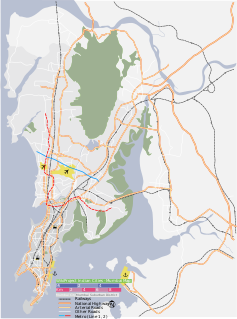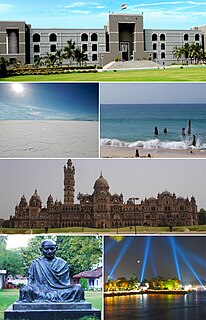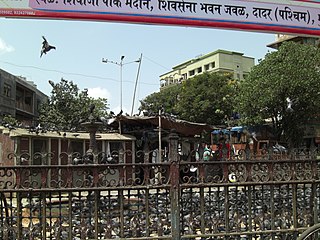| Pydhonie | |
|---|---|
| neighbourhood | |
| Coordinates: 18°57′14″N72°50′10″E / 18.9540°N 72.8361°E Coordinates: 18°57′14″N72°50′10″E / 18.9540°N 72.8361°E | |
| Country | |
| State | Maharashtra |
| District | Mumbai City |
| Metro | Mumbai |
| Zone | 1 |
| Ward | B |
| Government | |
| • Body | MCGM |
| Elevation | 11 m (36 ft) |
| Languages | |
| • Official | Marathi |
| Time zone | UTC+5:30 (IST) |
| PIN | 400 003 |
| Lok Sabha constituency | Mumbai South |
| Vidhan Sabha constituency | Mumbadevi |
| Civic agency | MCGM |
Pydhonie is a neighbourhood in South Mumbai. Etymologically the name is derived from the Marathi word Py which means feet, and dhoné which means "to wash". Thus the name means "A place where feet are washed."

South Mumbai is the Mumbai City district which is the southernmost precinct of Greater Mumbai. It extends from Colaba in the south to Mahim and Sion in the north. It comprises the city's main business localities, making it the wealthiest urban precinct in India. Property prices in South Mumbai are by far the highest in India and among the highest in the world.

Marathi is an Indo-Aryan language spoken predominantly by around 83 million Marathi people of Maharashtra, India. It is the official language and co-official language in the Maharashtra and Goa states of Western India, respectively, and is one of the 22 scheduled languages of India. At 83 million speakers in 2011, Marathi ranks 19th in the list of most spoken languages in the world. Marathi has the third largest number of native speakers in India, after Hindi & Bengali. The language has some of the oldest literature of all modern Indian languages, dating back to around 900 AD. The major dialects of Marathi are Standard Marathi and the Varhadi dialect. Koli and Malvani Konkani have been heavily influenced by Marathi varieties.
The name Pydhonie or "foot-wash", and probably refers to a small creek that formed at high tide between the Great Breach (separating the islands of Bombay and Worli) and Umarkhadi, the creek between the islands of Mazagaon and Mumbai (Bombay). This was probably the first land permanently reclaimed from the sea in Mumbai.
Umarkhadi is an area in South Mumbai near Byculla and Pydhone.

Mazagaon, also spelled Mazgaon and Mazagon, and pronounced by the Catholics as 'Mazgon' or 'Maz-a-gon' and the Marathi-speakers as Mazhgav. It is one of the seven islands of Mumbai. It is part of South Mumbai and can be reached by Byculla Station on the Central railway line and Dockyard Road Station on the Harbour Railway line. Located in Mazagaon are maritime companies like the Bombay Port Trust and Mazagaon Dock Ltd., the Mazagaon Court and Anglo-Indian schools including Rosary High School, St. Peters School, Antonio D'Souza High School and St. Mary's School.

Mumbai is the capital city of the Indian state of Maharashtra. As of 2011 it is the most populous city in India with an estimated city proper population of 12.4 million. The larger Mumbai Metropolitan Region is the second-most-populous metropolitan area in India, with a population of 21.3 million as of 2016. Mumbai lies on the Konkan coast on the west coast of India and has a deep natural harbour. In 2008, Mumbai was named an alpha world city. It is also the wealthiest city in India, and has the highest number of millionaires and billionaires among all cities in India. Mumbai is home to three UNESCO World Heritage Sites: the Elephanta Caves, Chhatrapati Shivaji Maharaj Terminus, and the city's distinctive ensemble of Victorian and Art Deco buildings.
Pydhonie separates the predominantly Muslim population of the eastern part of the inner city from the mainly Hindu part to the west. The main landmark is the Mumbadevi Temple, moved here from the Fort area in 1737 or 1766. The present structure was financed by a Prabhu goldsmith called Pandurang Shivaji. Many of the older houses in this area were built by immigrants from Gujarat and Rajasthan, and have the murals on the walls, jharokhas , balconies and ornate lintels typical of architecture from these states.

Gujarat is a state on the western coast of India with a coastline of 1,600 km (990 mi) – most of which lies on the Kathiawar peninsula – and a population in excess of 60 million. It is the sixth largest Indian state by area and the ninth largest state by population. Gujarat is bordered by Rajasthan to the northeast, Daman and Diu to the south, Dadra and Nagar Haveli and Maharashtra to the southeast, Madhya Pradesh to the east, and the Arabian Sea and the Pakistani province of Sindh to the west. Its capital city is Gandhinagar, while its largest city is Ahmedabad. The Gujarati-speaking people of India are indigenous to the state. The economy of Gujarat is the fifth-largest state economy in India with ₹14.96 lakh crore (US$210 billion) in gross domestic product and a per capita GDP of ₹157,000 (US$2,200).

Rajasthan is a state in northern India. The state covers an area of 342,239 square kilometres (132,139 sq mi) or 10.4 percent of the total geographical area of India. It is the largest Indian state by area and the seventh largest by population. Rajasthan is located on the northwestern side of India, where it comprises most of the wide and inhospitable Thar Desert and shares a border with the Pakistani provinces of Punjab to the northwest and Sindh to the west, along the Sutlej-Indus river valley. Elsewhere it is bordered by five other Indian states: Punjab to the north; Haryana and Uttar Pradesh to the northeast; Madhya Pradesh to the southeast; and Gujarat to the southwest.

A jharokha is a type of overhanging enclosed balcony used in the architecture of Rajasthan. It was also used in Indo-Islamic architecture. Jharokhas jutting forward from the wall plane could be used both for adding to the architectural beauty of the building itself or for a specific purpose. One of the most important functions it served was to allow women to see outside without being seen themselves. Alternatively, these windows could be used to position archers and spies.
The ‘1860 ’ engraved police station is the oldest in the city and has a history in the 1993 Bombay bombings, which followed the Bombay riots, wherein the "first bullet during the riots was fired near the Pydhonie station and the first bus stoning during the riots also happened in this jurisdiction," said Madhukar Zende, who was the ACP during the 1993 riots and is famous for his arrest of serial killer Charles Sobhraj. [1]
The 1993 Bombay bombings were a series of 12 bomb explosions that took place in Mumbai, India, then known as Bombay, on 12 March 1993. .The single-day attacks resulted in 257 fatalities and 713 injuries. The then-Chief Minister of Maharashtra, Sharad Pawar, announced that there had been thirteen blasts, including a fictitious bomb in a Muslim quarter of the city, to prevent the events from taking on a communal hue and to protect his secular votes.
The Bombay riots usually refers to the riots in Mumbai, in December 1992 and January 1993, in which around 700 people died. The riots were mainly due to escalations of hostilities after large scale violent protests by Muslims in reaction to the 1992 Babri Masjid Demolition by Hindu Karsevaks in Ayodhya.
Charles Sobhraj, is a French thief, fraudster and serial killer of Vietnamese and Indian origin who preyed on Western tourists, mainly beatniks, throughout The Hippie Trail of Southeast Asia during the 1970s. He was nicknamed The Splitting Killer and The Serpent, due to his skill at deception and evasion, as well as the Bikini Killer due to the attire of his victims. Sobhraj allegedly committed at least a dozen murders, and was convicted and jailed in India from 1976 to 1997. After his release, he retired as a celebrity in Paris. He returned to Nepal and was arrested. He was tried there and received a sentence of life imprisonment.











